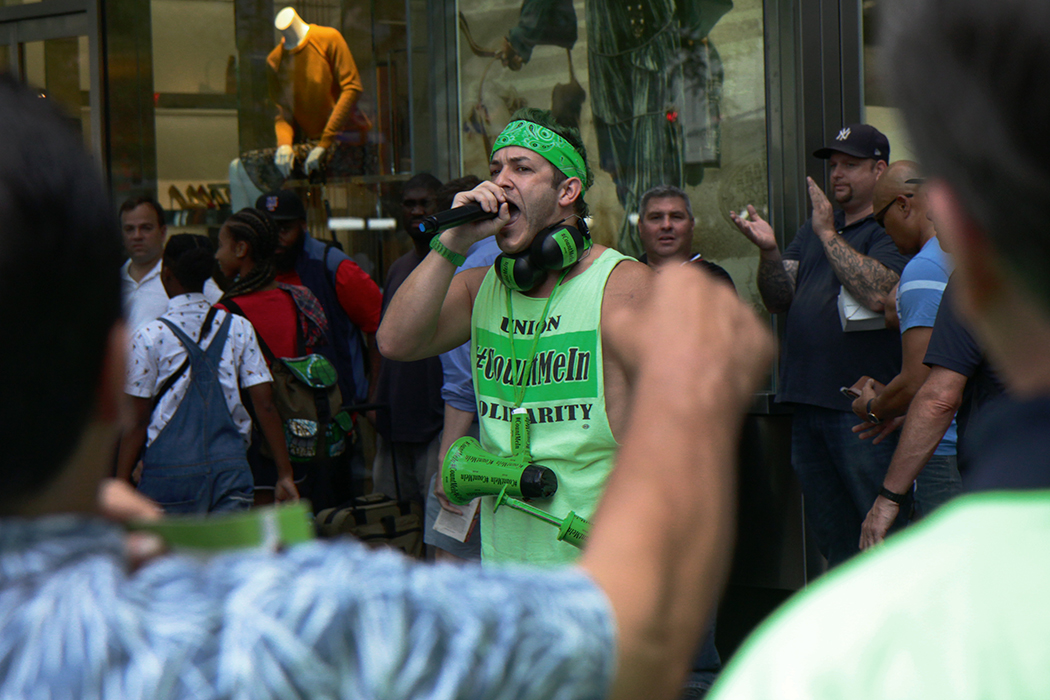It was a sweltering August day and Charlie Schultz was ready to raise hell. Schultz, a member of Long Island construction union Bricklayers and Allied Craftworkers Local 7 Tile, Marble & Terrazzo, dyed his hair green, packed his neon green air horn, donned a #CountMeIn tank top and traveled 30 miles from his home in Massapequa to join a rally of about 100 construction workers to protest in front of the Time Warner Center at Columbus Circle.
“Count Me In” is the name of the biweekly rally that the Building and Construction Trades Council of Greater New York, a construction union umbrella organization representing more than 100,000 workers, has been organizing for close to a year against Related Cos., the largest developer in New York City. Its goal is to force Related to exclusively use union labor at its Hudson Yards project, the city’s largest private real estate development since Rockefeller Center. On Aug. 7, the union workers, many of them clad in matching neon green shirts to show solidarity, made up for their modest numbers with volume and aggression. “New York City is a union town, if we don’t build it, shut it down,” they shouted until some of their voices grew hoarse.
As news headlines and the rallying cries heard at Columbus Circle and 50 Hudson Yards make clear, the New York City building trades unions have declared war. But the Building and Construction Trades Council’s rallies are not just a reaction to Related’s decision to use an open shop model, which allows for nonunion labor. They are a reaction to a systemic challenge in New York City: the rise of nonunion subcontractors.
Historically, governmental and commercial construction have been the bread and butter of the building trades. The construction unions have not been as dominant in small-scale residential construction, which has thinner margins and does not require the level of technical expertise that the unions provide. Now, Related’s decision to adopt an open shop model represents a potential fissure in union labor’s cement grip on the nonresidential and commercial sectors. The rallies are a way to draw attention to this issue.
“The unfortunate reality is that certain developers have really tried to promote the idea that the unions have lost all this market share and are in a weakened position.” – Gary LaBarbera, Building and Construction Trades Council president
Yet while there’s anecdotal evidence to suggest that the nonunion sector is gaining traction, the data that both sides are using to measure the extent of the trend is imprecise and inconsistent. During the recovery from the Great Recession, New York City has embarked on an unprecedented construction boom that’s increased both union and nonunion activity. There may be consensus among labor officials, developers and academics that there’s more nonunion activity than before the recession, but the degree to which this activity encroaches on the union market share is unclear.
“If you’re talking about 2018 compared to a decade ago or compared to the 1980s, undoubtedly the nonunion share of overall construction activity has increased,” said James Parrott, director of economic and fiscal policies at The New School’s Center for New York City Affairs (no relation to the author). “But other than some sort of vague statement like that, I’m not ready to put numbers behind anything.”
Building and Construction Trades Council President Gary LaBarbera told City & State that the organization measures dollars spent per year on construction to loosely track the nonunion market share. This information comes from the New York Building Congress’ Construction Outlook report, which separates the industry into three segments: commercial, governmental and residential.The latest report found that governmental and commercial construction, the two sectors that are largely dominated by unions, spent the most money. Last year, $17.4 billion was expected to be spent on nonresidential construction, $11 billion on residential and $16.9 billion by the government. Though the Building and Construction Trades Council, or BCTC, treats it as a marker of their hold on the industry, the report does not examine union and nonunion market share within these subcategories.
The Regional Plan Association’s 2011 Construction Labor Costs in New York City report concluded that “nonunion construction jobs, which constituted roughly 10 percent of the industry in the 1970s, are now generally thought to be 40 percent – and growing.” But when City & State asked how the RPA reached that figure, a spokesperson responded that “the calculation was based on extensive interviews with every major developer and contractor group,” rather than data collection.
In the absence of conclusive data, LaBarbera maintains that nonunion work has not infiltrated the commercial sector. “The notion that we are losing is absolutely incorrect. The only place again that there is a penetration (of nonunion labor) really is in residential construction,” LaBarbera told City & State.
LaBarbera went on to say that he believes that developers have been using media campaigns to attack the notion of union competence in an attempt to rein in union bargaining power and expand their own margins. “The unfortunate reality is that there are certain developers, and Related is one of them, that have really tried to promote the idea that the unions have lost all this market share and are in a weakened position,” he said. “They have been, for the last several years, very antagonistic towards the unions and have tried to promote the open shop model.”
A Related spokesperson said in a statement: “The campaign undertaken by the BCTC is nothing more than a misguided attempt to assert their relevancy and Mr. LaBarbera and the BCTC are doing a disservice to individual unions and their members who want to work on future phases of the project by attempting to prevent them from negotiating in good faith with us.”
Related also referred City & State to a 2015 study by the Building Trades Employers’ Association that bolsters their view that nonunion market share is increasing. The study concluded that union market share for projects 10 stories and higher was 24 percent in 2015. But the figure uses building permits as the metric of market share, which is imprecise since it inflates the importance of smaller nonunion projects that make less money. The figure also does not account for government construction, which is dominated by unions, and uses nonunion construction to mean open shop sites, which often use some union labor.

Not everyone with the BCTC is as dismissive of the gravity of the construction unions’ predicament. Though he showed the same stiff-necked confidence in BCTC’s ability to win the fight against Related, Mike Hellstrom, the campaign director of Count Me In, said that nonunion commercial labor poses a serious risk. As workers gathered at the Columbus Circle rally, Hellstrom told City & State that the growth of nonunion, nonresidential construction is “one of the biggest risks that union construction workers are facing right now.”
Up until this past fall, Related had used union labor exclusively during its 40-year history. In its lawsuit filed in March, the company claimed that the BCTC failed to ensure that its affiliated unions adhered to the project labor agreement they had laid out, and that this supervisory failure inflated construction costs by more than $100 million.
As the biggest game in town, Related’s embrace of the open shop model carries symbolic weight, but it is not the only large developer who has declined to sign agreements promising to use only union labor on nonresidential projects – others include The Durst Organization, Tishman Construction Corp., and Turner Construction Co.
At an average cost of $362 per square foot, New York City is currently the most expensive place to build in the world. Developers like Related argue that the city’s construction work has reached a tipping point where they are no longer able to bear the costs. While reports like the RPA’s conclude that the expense of organized labor is to blame for this, some labor experts argue that these reports operate on a misleading premise.
“As an economist, it’s very problematic to say that just going from the price of something to equating the price of something to the value of something is a big no-no,” Parrott said. “It disregards the fact that union construction labor is much more productive than nonunion.”
All union construction workers go through a multiyear apprenticeship program that teaches manual and vocational skills related to each trade. As studies have shown, the result is that union workers per hour are much more productive than nonunion. “If you have a lot of work done by unskilled workers, a lot of (the) time it has to be redone so you have to rip out all that material,” Parrott said. “So there’s more labor time in ripping out materials, then there’s the cost of the materials that then get thrown away and other work has to be redone.”
“The sophistication of the nonunion trades is increasing and they’re able to do more and more difficult jobs, especially outside of Manhattan.” Jordan Barowitz, The Durst Organization spokesman
On the other hand, the boom in nonunion residential construction has given that sector more resources and reasons to adapt and take advantage of openings in the market. “The sophistication of the nonunion trades is increasing and they’re able to do more and more difficult jobs, especially outside of Manhattan,” said Jordan Barowitz, a spokesman for The Durst Organization, a developer that was also the target of union protests this summer over its hiring of a nonunion concrete contractor. “The union pay scale and the work rules are onerous and make outer borough rental housing construction economically infeasible.”
The Building Congress’ report does illustrate that construction spending is shifting. While the report had projected a drop in residential construction last year, the sector had been steadily growing for the previous six years. According to the Construction Outlook for 2017-19, more than 72,000 new housing units were constructed in New York City in 2015 and 2016, which was the most productive two-year period for residential construction in more than two decades.
The unions are in a position where they’re balancing their established dominance in commercial construction against the shifting tides flowing into the residential sphere. Nonunion contractors may be picking up more commercial construction, but LaBarbera said the BCTC has been expanding its residential activity over the past couple years. “Union trades are working on these traditionally nonunion jobs,” he said.
The market is pushing organized and nonunion labor to interchange their traditional roles, but the effectiveness of these strategies is unclear. The question for unions remains: How do they devise an effective survival strategy without definitive evidence of whether its working?
If the Count Me In rallies make one thing clear, it’s that BCTC is reluctant to give up any ground. “We will not go away from this marketplace silently,” Hellstrom said.


